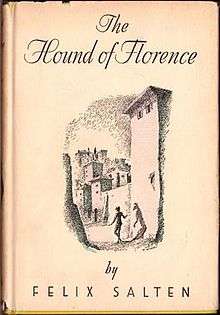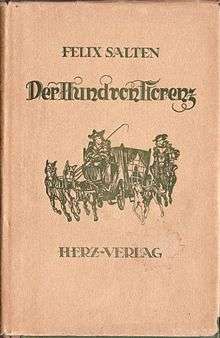The Hound of Florence
The Hound of Florence: A Novel (German: Der Hund von Florenz) is a 1923 novel written by Felix Salten. It is best known today for partly inspiring (and even mentioned in) the 1959 Walt Disney Pictures film, The Shaggy Dog, as well as a sequel and remakes. The novel was first translated into English in 1930 by Huntley Paterson, and the translation has illustrations by Kurt Wiese.
 Cover of the American edition. | |
| Author | Felix Salten |
|---|---|
| Original title | Der Hund von Florenz |
| Translator | Huntley Paterson |
| Illustrator | Kurt Wiese |
| Country | Austria |
| Language | German |
| Genre | novel |
| Publisher | Simon and Schuster |
Publication date | 1923 |
Published in English | 1930 |
| Pages | 237 |
| OCLC | 1826868 |
Plot
The Hound of Florence is an adventure story for young readers, set in early eighteenth-century Austria and Italy. The adolescent Lukas Grassi has lost his parents and lives in Vienna in great poverty, longs for his native Italy, and would like to study art in Florence. By magic, his wish is granted, but every other day he must take the form of a dog, Kambyses,[1] that belongs to the Archduke Ludwig; and alternating daily between human and canine form, he travels from Vienna to Florence along with the Archduke's troops, and there has to lead a unique double life. This is the only book of Salten in which supernatural elements occur, and they may show influence of E. T. A. Hoffmann.[2]
The ending of the book differs greatly in the original language and in the English translation. The German-language version ends in tragedy: the archduke stabs the dog to death with a dagger, killing Lukas, and his body is disposed of. In the English translation, a wholly new ending of six more pages[3] has been written: Lukas survives, gets medication and is united with the courtesan. Currently it is not known if the alternate ending is authorized.
Background
The book has some "overtly" autobiographical background. In 1890s the journalist Salten had become a friend and confidant of the Austrian archduke Leopold Ferdinand, and in his novel, Salten makes use of his experiences with the archduke and his brothers. He carried the material for twenty-five years before he dared to write the story. In 1907 he mentioned Arthur Schnitzler that he was then about to finish the manuscript. However it was not until 1921 when the manuscript was completed.[4]
Certain recurring motifs in Saltens œuvre appear also in this book: the deep cleavage between the very rich and the very poor, and the critique of the nobility.[5]
According to Salten's biographer Beverley Driver Eddy, the strength of The Hound of Florence lies in the depiction of the dog Kambyses – a "brilliant portrayal of a dog's character."[6] Salten himself was a passionate dog lover and kept dogs most of his life.[7]
The Hound of Florence is written as one piece. There are no chapter divisions. The 1920s German-language editions, set in Fraktur, however use an embellished dash to divide the text into large sections,[8] and a 1980s edition uses asterisks for that purpose.[9]
Availability
The English-language edition of The Hound of Florence was out of print for a long time. Only 2014 was a new edition published, this time illustrated by Richard Cowdrey, using the alternate ending.[10] The novel was translated into French in 1952.[11] The Finnish-language edition from 2016 includes both endings.[12]
References

- In the English translation, the names are spelled "Lucas Grassi" and "Cambyses."
- Ehness, Jürgen (2002). Felix Saltens erzählerisches Werk: Beschreibung und Deutung (in German). Frankfurt am Main: Peter Lang. p. 221. ISBN 3-631-38178-6.
- From page 230 on, the English translation diverts from and expands the German text.
- Eddy, Beverley Driver (2010). Felix Salten: Man of Many Faces. Riverside (Ca.): Ariadne Press. pp. 33, 87–89, 131, 195–196, 204–205. ISBN 978-1-57241-169-2.
- Ehness (2002), p. 219.
- Eddy (2010), p. 195.
- Eddy (2010), p. 33.
- Salten, Felix (1923). Der Hund von Florenz. Wien: Herz-Verlag.
- Salten, Felix (1985). Der Hund von Florenz. Cotta's Bibliothek der Moderne, 42. Stuttgart: Klett-Cotta. ISBN 3-608-95400-7.
- Salten, Felix (2014). The Hound of Florence. Illustrated by Richard Cowdrey. New York: Aladdin. ISBN 978-1-4424-8749-9.
- Salten, Felix (1952). Le chien de Florence (in French). Traduit de l’allemand par Maurice Muller-Straus. Bruxelles: Éditions de la Paix.
- Salten, Felix (2016). Koiramme Firenzessä (in Finnish). Translated by Markus Lång. Helsinki: Books on Demand GmbH. ISBN 978-952-330-150-4.
External links
- Der Hund von Florenz at Faded Page (Canada) in German language.